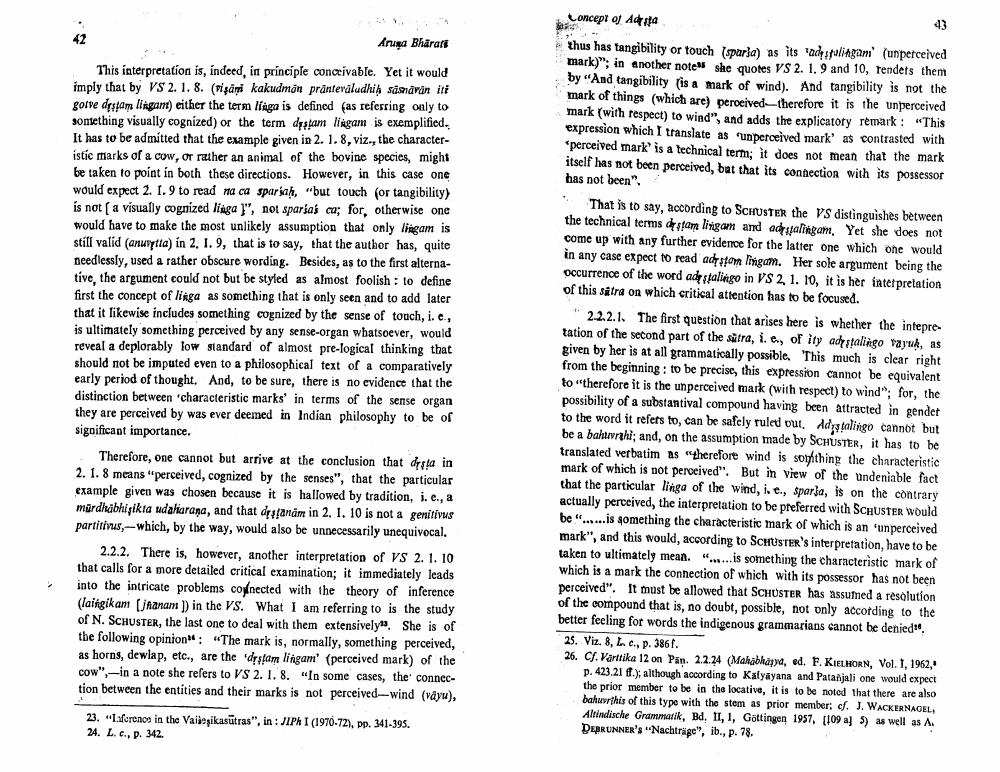Book Title: Note On Concept Adrsta As Used In Vaisesika Sutra Author(s): A Wezler Publisher: A Wezler View full book textPage 5
________________ Concept of Adra Aruga Bharati This interpretation is, indeed, in principle conceivable. Yet it would imply that by VS 2. 1. 8. (Fişămi kakudmôn pränteväludhih sasaran iti gotve drstam lingant) either the term linga is defined as referring only to sontcthing visually cognized) or the term distam lagam is exemplified. It has to be admitted that the example given in 2. 1. 8, viz., the characteristic marks of a cow, or rather an animal of the bovine species, might be taken to point in both these directions. However, in this case one would expect 2. 1.9 to read na ca sparsah, "but touch (or tangibility) is not a visually cognized liaga l", not sparsas ca; for, otherwise one would have to make the most unlikely assumption that only lingam is still valid (anuvytta) in 2. 1. 9, that is to say, that the author has, quite needlessly, used a rather obscure wording. Besides, as to the first alternative, the argument could not but be styled as almost foolish: to define first the concept of linga as something that is only seen and to add later that it likewise includes something cognized by the sense of touch, i.e., is ultimately something perceived by any sense-organ whatsoever, would reveal a deplorably low standard of almost pre-logical thinking that should not be imputed even to a philosophical text of a comparatively early period of thought. And, to be sure, there is no evidence that the distinction between characteristic marks' in terms of the sense organ they are perceived by was ever deemed in Indian philosophy to be of significant importance. thus has tangibility or touch (sparla) as its adspulingam (unperceived mark)"; in another notes she quotes VS 2. 1. 9 and 10, tendets them by "And tangibility is a mark of wind). And tangibility is not the mark of things (which are) peroeived-therefore it is the unperceived mark (with respect) to wind", and adds the explicatoty remark: "This expression which I translate as underceived mark' as contrasted with *perceived mark' is a technical term; it does not mean that the mark itself has not been perceived, but that its connection with its possessor has not been". That is to say, according to SCHUSTER the VS distinguishes between the technical terms desam lisigam and adorsalingam. Yet she does not come up with any further evidence for the latter one which one would in any case expect to read aestom lingam. Her sole argument being the occurrence of the word adesalingo in VS 2 1. 10, it is her interpretation of this sätra on which critical attention has to be focused. " 2.2.2.1. The first question that arises here is whether the intepretation of the second part of the sætra, i. e, of ity adystalingo vayuk, as given by her is at all grammatically possible. This much is clear right from the beginning to be precise, this expression cannot be equivalent to "therefore it is the unperceived mark (with respect) to wind"; for, the possibility of a substantival compound having been attracted in gendet to the word it refers to, can be safely ruled out. Adatalingo cannot but be a bahuvi; and, on the assumption made by SCHUSTER, it has to be translated verbatim as therefore wind is soighthing the characteristic mark of which is not perceived". But in view of the undeniable fact that the particular linga of the wind, i.e., sparja, is on the contrary actually perceived, the interpretation to be preferred with SCHUSTER would be"...... is something the characteristic mark of which is an unperceived mark", and this would, according to SCHUSTER's interpretation, have to be taken to ultimately mean. "...... is something the characteristic mark of which is a mark the connection of which with its possessor has not been perceived". It must be allowed that SCHUSTER has assufned a resolution of the compound that is, no doubt, possible, not only according to the better feeling for words the indigenous grammarians cannot be deniedu 25. Viz. 8, L. c., p. 3861. 26. Cf. Värttika 12 on Pan. 2.2.24 (Mahābhagyd, ed. E. KIEL HORN, Vol. 1, 1962, p. 423.21 f.); although according to Kalyayana and Patanjali one would expect the prior member to be in the locative, it is to be noted that there are also bahurthis of this type with the stem as prior member; cf. J. WACKERNAGEL. Altindische Grammatik, Bd. II, 1, Göttingen 1957, [109 a 5) as well as A DEPRUNNER'S "Nachtrage", ib., p. 78. Therefore, one cannot but arrive at the conclusion that drsta in 2. 1. 8 means "perceived, cognized by the senses", that the particular example given was chosen because it is hallowed by tradition, i. c., a mürdhäbhişikta udaliaraņa, and that drsanam in 2. 1. 10 is not a genitivus partitivus, -which, by the way, would also be unnecessarily unequivocal. 2.2.2. There is, however, another interpretation of VS 2. 1. 10 that calls for a more detailed critical examination; it immediately leads into the intricate problems conected with the theory of inference (laingikam janam in the VS. What I am referring to is the study of N. SCHUSTER, the last one to deal with them extensively. She is of the following opinion": "The mark is, normally, something perceived, as horns, dewlap, etc., are the distam lingam' (perceived mark) of the cow",-in a note she refers to VS 2. 1. 8. "In some cases, the connection between the entities and their marks is not perceived-wind (väyu), 23. Laforence in the Vallepikasutras", in: JIPRI (1970-72), pp. 341-395. 24. L. c., p. 342.Page Navigation
1 ... 3 4 5 6 7 8 9 10 11 12 13
